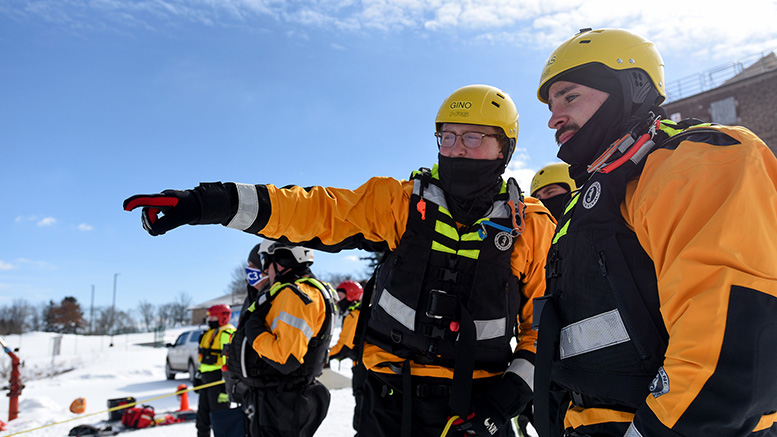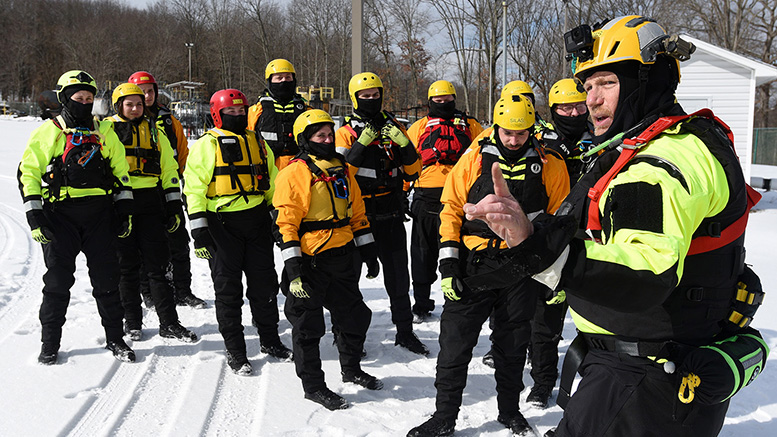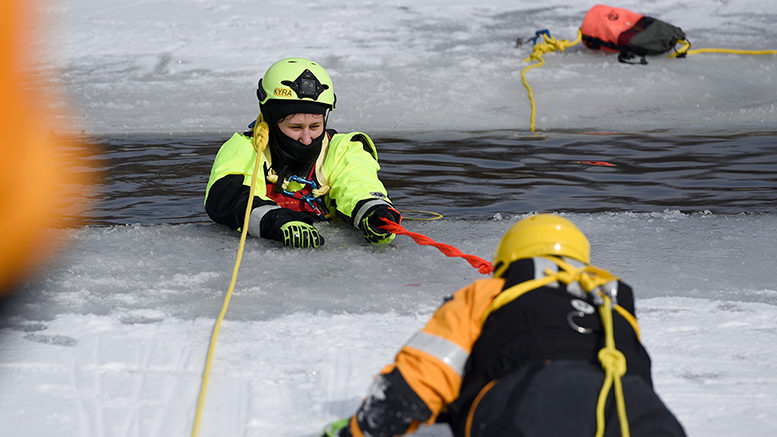The air temperature is 24 degrees Fahrenheit, feeling more like 19 in this breeze, and the water, just under this 4-inch mantle of ice, is 32.
Across campus, her contemporaries enrolled in Butler County Community College’s 54 other associate-degree programs are at this moment indoors, dry, warm. At least they’re not here. Not out here. And certainly not about to inch stomach-down atop the Pennsylvania college’s public safety training facility pond toward a 6-foot by 4-foot pool.
Kyra Costar is the first of 12 park and recreation management program students at Butler County Community College (BC3) who on February 17 also dropped into the 17-foot-deep water exposed by chainsaw an hour earlier.
The 20-year-old is pursuing ice rescue and emergency response technician certification through BC3’s program and from the Pennsylvania Fish and Boat Commission. Over the next 40 minutes, Costar will use her elbows pressed atop the frozen ledge to repeat pulling herself onto the ice shelf.
Then drop back into the water.
She’ll plant the spiked end of a 6-foot staff into the frozen ledge and repeat pulling herself onto the ice shelf.
Then drop back into the water.
She’ll stab the spiked ends of 4-inch wooden ice awls into the frozen ledge and repeat pulling herself onto the ice shelf.
Then drop back into the water.
She has learned to rescue herself. Now, Trey Barto will learn how to rescue another.
(Below) Watch BC3’s ice-rescue training in action
Barto, likewise protected by a drysuit and personal flotation device, will likewise tap the 6-foot staff onto the ice ahead of his bootsteps, listening for inconsistencies, then kneel and slide on his stomach, distributing his weight, to inch toward Costar 20 yards offshore.
He’ll practice pulling Costar onto the ice shelf using the tethered end of the 6-foot staff. Then enter the 32-degree water himself, where he will connect Costar to a harness, later to a U-shaped ice rescue sling, enabling both to be pulled to safety by classmates grasping the other end of a 3/8-inch polypropylene throw line from the snow-covered shore.
Out of their comfort zone
“This group is learning the tactics,” said Chris Calhoun, a BC3 park and recreation management professor, technical resource specialist and rescue technician with the Butler County Water Rescue Team 300. “With these skill sets, we have to do a thorough job to the best of our abilities to teach them because the next time they may use these skills may be an actual rescue.”
Costar chose BC3’s career program to prepare for work in recreational management in Colorado. Barto did so to become an officer with the state Game Commission. Silas Bruno, to become a ranger with the National Park Service, and Ellie Robinson, to become a park ranger with the state Department of Conservation and Natural Resources.

They are among the dozen 19- to 37-year-olds pursuing the ice rescue and emergency response technician certification from the Pennsylvania Fish and Boat Commission through BC3’s four-credit park safety and visitor services course.
BC3’s two-year career program also offers opportunities for certifications in advanced line systems rescue, CPR and AED for the professional rescuer, first responder, water rescue and emergency response, wildland firefighter training and in other areas.
Ice rescue and emergency response technician certification requires proficiency in ice travel, self-rescue, ice-based rescue, boat- and platform-based rescue and direct-contact rescue – “They have to demonstrate competence in all skills,” Calhoun said – and that students score 80 percent or higher on a written test.
“Having this experience will help me with my career goals,” Costar said. “I learned to step out of my comfort zone and know that I could do something like that.”
As did Barto.
“I definitely was a little nervous to get in that ice at first only because I have never been in a situation like that,” he said. “It was a little nerve-racking at first, but after a while you kind of get more used to it and feel comfortable with it. I was glad to overcome that fear of getting in that ice.”
Developing the skills
The college’s park safety and visitor services course instructs students in basic law enforcement and in rescue techniques that apply to park and recreation areas. The course is required in the second semester of BC3’s park and recreation management law enforcement option track and in the fourth semester of its general option track. Each track requires 61 credits to earn an associate degree.
Over and over, Costar, Barto, Bruno, Robinson and their classmates practiced pulling themselves and one another onto a frozen ledge that would become water covered and begin to soften over the afternoon. Ultimately, they practiced rescues using a 12-foot-long inflatable rapid deployment craft.

“The challenge in Pennsylvania is that ice conditions can be good for a very short period of time, and then go bad very fast,” said Calhoun, who also serves as a member of the Pennsylvania Helicopter Aquatic Rescue Team and as the lead water-rescue instructor trainer for the Pennsylvania Fish and Boat Commission. “People could go out recreating on the ice or walking on the ice early in the morning and maybe not have issues. But if the sun comes out and the temperatures rise, and there is water on the surface, that ice condition can deteriorate very quickly.
“On their way back, they fall through because it has changed,” Calhoun said. “It changed in just that short amount of time.”
The training is important “so if we are ever put into an emergency situation, we’re prepared,” said Robinson, 19. “We can stay calm and understand what we need to do to help people out.”
Prepared for the worst
Students taking the park safety and visitor services course will pursue certifications in water rescue and emergency response April 14, and in advanced line systems rescue April 21 and April 28.
“BC3 really has everything we need to get us a good jump start in our career,” Barto said.
His career will include search and rescue, said Bruno, who wants to work for the National Park Service.
“So knowing how to rescue somebody in all sorts of situations, including ice rescue, is very important,” he said. “This was actual ice. Some of the ropes were freezing. When you had to disconnect out of the system, the harness and hardware was frozen.
“This was learning how to coordinate getting someone out there, making sure the line tenders are doing what they’re supposed to do, paying attention to what your rescuer is doing, how the victim is, how their condition is.
“It was paying attention to everything.”

